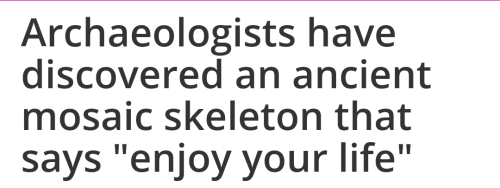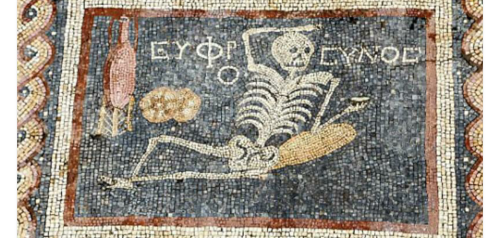Once I was made of stardust. Now I am made of flesh and I can experience our agreed-upon reality and said reality is exciting and beautiful and terrifying and full of interesting things to compile on a blog! / 27 / ENTP / they-them / Divination Wizard / B.E.y.O.N.D. department of Research and Development / scientist / science enthusiast / [fantasyd20 character]
162 posts
Latest Posts by in-pursuit-of-knowledge-blog - Page 3
Genetics are weird and interesting!!

From Twitter.
WELL AIN’T THAT SOME SHIT.
How 250 Siberians Became the First Native Americans

The Americas are a big place, but the Native American group that first settled it was small — just about 250 people, according to a new genetic study.
These people, known as a founding group because they “founded” the first population, migrated from Siberia to the Americas by about 15,000 years ago, said study co-lead researcher Nelson Fagundes, a professor in the Department of Genetics at Federal University of Rio Grande do Sul, in Brazil.
Figuring out the size of founding groups is key, because it determines the amount of genetic diversity that gets passed on to the group’s descendants, Fagundes said.
That, in turn, could alter how effectively natural selection weeds out bad genes, Fagundes said.
“Large populations have very efficient selection, while in small populations, mildly deleterious alleles [versions of genes] can spread, which may increase genetic susceptibility to some diseases,” Read more.
Solar System 10 Things to Know: Planetary Atmospheres
Every time you take a breath of fresh air, it’s easy to forget you can safely do so because of Earth’s atmosphere. Life on Earth could not exist without that protective cover that keeps us warm, allows us to breathe and protects us from harmful radiation—among other things.
What makes Earth’s atmosphere special, and how do other planets’ atmospheres compare? Here are 10 tidbits:
1. On Earth, we live in the troposphere, the closest atmospheric layer to Earth’s surface. “Tropos” means “change,” and the name reflects our constantly changing weather and mixture of gases.

It’s 5 to 9 miles (8 to 14 kilometers) thick, depending on where you are on Earth, and it’s the densest layer of atmosphere. When we breathe, we’re taking in an air mixture of about 78 percent nitrogen, 21 percent oxygen and 1 percent argon, water vapor and carbon dioxide. More on Earth’s atmosphere›

2. Mars has a very thin atmosphere, nearly all carbon dioxide. Because of the Red Planet’s low atmospheric pressure, and with little methane or water vapor to reinforce the weak greenhouse effect (warming that results when the atmosphere traps heat radiating from the planet toward space), Mars’ surface remains quite cold, the average surface temperature being about -82 degrees Fahrenheit (minus 63 degrees Celsius). More on the greenhouse effect›

3. Venus’ atmosphere, like Mars’, is nearly all carbon dioxide. However, Venus has about 154,000 times more carbon dioxide in its atmosphere than Earth (and about 19,000 times more than Mars does), producing a runaway greenhouse effect and a surface temperature hot enough to melt lead. A runaway greenhouse effect is when a planet’s atmosphere and surface temperature keep increasing until the surface gets so hot that its oceans boil away. More on the greenhouse effect›

4. Jupiter likely has three distinct cloud layers (composed of ammonia, ammonium hydrosulfide and water) in its “skies” that, taken together, span an altitude range of about 44 miles (71 kilometers). The planet’s fast rotation—spinning once every 10 hours—creates strong jet streams, separating its clouds into dark belts and bright zones wrapping around the circumference of the planet. More on Jupiter›

5. Saturn’s atmosphere—where our Cassini spacecraft ended its 13 extraordinary years of exploration of the planet—has a few unusual features. Its winds are among the fastest in the solar system, reaching speeds of 1,118 miles (1,800 kilometers) per hour. Saturn may be the only planet in our solar system with a warm polar vortex (a mass of swirling atmospheric gas around the pole) at both the North and South poles. Also, the vortices have “eye-wall clouds,” making them hurricane-like systems like those on Earth.
Another uniquely striking feature is a hexagon-shaped jet streamencircling the North Pole. In addition, about every 20 to 30 Earth years, Saturn hosts a megastorm (a great storm that can last many months). More on Saturn›

6. Uranus gets its signature blue-green color from the cold methane gas in its atmosphere and a lack of high clouds. The planet’s minimum troposphere temperature is 49 Kelvin (minus 224.2 degrees Celsius), making it even colder than Neptune in some places. Its winds move backward at the equator, blowing against the planet’s rotation. Closer to the poles, winds shift forward and flow with the planet’s rotation. More on Uranus›

7. Neptune is the windiest planet in our solar system. Despite its great distance and low energy input from the Sun, wind speeds at Neptune surpass 1,200 miles per hour (2,000 kilometers per hour), making them three times stronger than Jupiter’s and nine times stronger than Earth’s. Even Earth’s most powerful winds hit only about 250 miles per hour (400 kilometers per hour). Also, Neptune’s atmosphere is blue for the very same reasons as Uranus’ atmosphere. More on Neptune›

8. WASP-39b, a hot, bloated, Saturn-like exoplanet (planet outside of our solar system) some 700 light-years away, apparently has a lot of water in its atmosphere. In fact, scientists estimate that it has about three times as much water as Saturn does. More on this exoplanet›

9. A weather forecast on “hot Jupiters”—blistering, Jupiter-like exoplanets that orbit very close to their stars—might mention cloudy nights and sunny days, with highs of 2,400 degrees Fahrenheit (about 1,300 degrees Celsius, or 1,600 Kelvin). Their cloud composition depends on their temperature, and studies suggest that the clouds are unevenly distributed. More on these exoplanets›

10. 55 Cancri e, a “super Earth” exoplanet (a planet outside of our solar system with a diameter between Earth’s and Neptune’s) that may be covered in lava, likely has an atmosphere containing nitrogen, water and even oxygen–molecules found in our atmosphere–but with much higher temperatures throughout. Orbiting so close to its host star, the planet could not maintain liquid water and likely would not be able to support life. More on this exoplanet›
Read the full version of this week’s Solar System 10 Things to Know HERE.
Make sure to follow us on Tumblr for your regular dose of space: http://nasa.tumblr.com.

Hey dudes! I finally set up an Etsy!
I’ve got a few items listed right now. Various skulls and natural things. Would be rad if y'all could check it out even if it just means getting a few views haha.
Ill probably be fixing it up all nice with a custom logo and adding more things soon so Ill update when that happens.





Linguistics takes on the “Is this a pigeon” meme.
it is absolutely my kind of thing. so much work, such intricate pieces! I would’ve loved to be on the team that put this together.
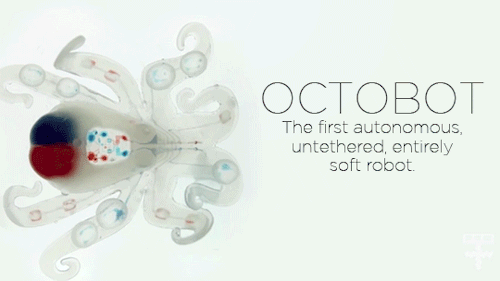
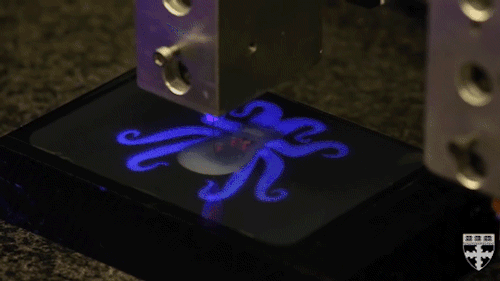
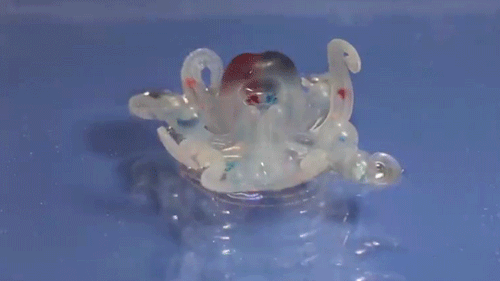
Creepy or adorable? Researchers at Harvard University have demonstrated the first autonomous, untethered, entirely soft robot: the octobot.
Instead of being controlled by electronics, the robot’s logic board is powered by chemical reactions and fluid passing along tiny channels. Scientist have struggled to create completely soft robots because rigid components like circuit boards, power sources and electronic controls are difficult to replace.
Learn more about the octobot and soft robotics here and see the full study published in Nature here.
Videos Credit: Harvard SEAS/Image Credit Lori Sanders
news report: survey says
me: what was the sample size? the distribution? the demographic??? this is meaningless. you could have asks two people in line at starbucks
Research is formalized curiosity. It is poking and prying with a purpose.
Zora Neale Hurston (via berghahnbooks)
How does the brain learn categorization for sounds?

Photo credit: Xiong Jiang, Georgetown University
Categorization, or the recognition that individual objects share similarities and can be grouped together, is fundamental to how we make sense of the world. Previous research has revealed how the brain categorizes images. Now, researchers funded by the National Science Foundation (NSF) have discovered that the brain categorizes sounds in much the same way.
To find out how the brain categorizes auditory input, the researchers invented new sounds using an acoustic blending tool to produce sounds from two types of monkey calls. The blending produced hundreds of new sounds that differed from the original calls.
Subjects listened to several hundred calls and categorized them under two arbitrary labels that were created by the researchers. The researchers used functional MRI prior to and following the training to image subjects’ brains while they listened to the sounds, but did not yet label them. The results showed that learning to categorize the sounds had increased the brain’s sensitivity to the acoustic features that distinguished one sound from another.
Researchers believe these findings reveal what may not only be a general mechanism about how the brain learns, but also about how learning changes the brain and allows the brain to build on that learning. The work has potential implications for understanding individual differences in language learning and can provide a foundation for understanding and treating people with learning disorders and other disabilities.
Learn more here: http://bit.ly/2vri3Ij
I’ll have to look into that next time I’m near Lantern!
just woke up from one hell of a nightmare i need a distraction…
it’s really not as bad as you might think!
honey is the only food product that never spoils. there are pots of honey that are over five thousand years old and still completely edible
10 Things: Journey to the Center of Mars
May the fifth be with you because history is about to be made: As early as May 5, 2018, we’re set to launch Mars InSight, the very first mission to study the deep interior of Mars. We’ve been roaming the surface of Mars for a while now, but when InSight lands on Nov. 26, 2018, we’re going in for a deeper look. Below, 10 things to know as we head to the heart of Mars.

Coverage of prelaunch and launch activities begins Thursday, May 3, on NASA Television and our homepage.
1. What’s in a name?

“Insight” is to see the inner nature of something, and the InSight lander—a.k.a. Interior Exploration using Seismic Investigations, Geodesy and Heat Transport—will do just that. InSight will take the “vital signs” of Mars: its pulse (seismology), temperature (heat flow) and reflexes (radio science). It will be the first thorough check-up since the planet formed 4.5 billion years ago.
2. Marsquakes.
You read that right: earthquakes, except on Mars. Scientists have seen a lot of evidence suggesting Mars has quakes, and InSight will try to detect marsquakes for the first time. By studying how seismic waves pass through the different layers of the planet (the crust, mantle and core), scientists can deduce the depths of these layers and what they’re made of. In this way, seismology is like taking an X-ray of the interior of Mars.
Want to know more? Check out this one-minute video.
3. More than Mars.

InSight is a Mars mission, but it’s also so much more than that. By studying the deep interior of Mars, we hope to learn how other rocky planets form. Earth and Mars were molded from the same primordial stuff more than 4.5 billion years ago, but then became quite different. Why didn’t they share the same fate? When it comes to rocky planets, we’ve only studied one in great detail: Earth. By comparing Earth’s interior to that of Mars, InSight’s team hopes to better understand our solar system. What they learn might even aid the search for Earth-like planets outside our solar system, narrowing down which ones might be able to support life.
4. Robot testing.
InSight looks a bit like an oversized crane game: When it lands on Mars this November, its robotic arm will be used to grasp and move objects on another planet for the first time. And like any crane game, practice makes it easier to capture the prize.
Want to see what a Mars robot test lab is like? Take a 360 tour.
5. The gang’s all here.

InSight will be traveling with a number of instruments, from cameras and antennas to the heat flow probe. Get up close and personal with each one in our instrument profiles.
6. Trifecta.

InSight has three major parts that make up the spacecraft: Cruise Stage; Entry, Descent, and Landing System; and the Lander. Find out what each one does here.
7. Solar wings.
Mars has weak sunlight because of its long distance from the Sun and a dusty, thin atmosphere. So InSight’s fan-like solar panels were specially designed to power InSight in this environment for at least one Martian year, or two Earth years.
8. Clues in the crust.

Our scientists have found evidence that Mars’ crust is not as dense as previously thought, a clue that could help researchers better understand the Red Planet’s interior structure and evolution. “The crust is the end-result of everything that happened during a planet’s history, so a lower density could have important implications about Mars’ formation and evolution,” said Sander Goossens of our Goddard Space Flight Center in Greenbelt, Maryland.
9. Passengers.

InSight won’t be flying solo—it will have two microchips on board inscribed with more than 2.4 million names submitted by the public. “It’s a fun way for the public to feel personally invested in the mission,” said Bruce Banerdt of our Jet Propulsion Laboratory, the mission’s principal investigator. “We’re happy to have them along for the ride.”
10. Tiny CubeSats, huge firsts.

The rocket that will loft InSight beyond Earth will also launch a separate NASA technology experiment: two mini-spacecraft called Mars Cube One, or MarCO. These suitcase-sized CubeSats will fly on their own path to Mars behindInSight. Their goal is to test new miniaturized deep space communication equipment and, if the MarCOs make it to Mars, may relay back InSight data as it enters the Martian atmosphere and lands. This will be a first test of miniaturized CubeSat technology at another planet, which researchers hope can offer new capabilities to future missions.
Check out the full version of ‘Solar System: 10 Thing to Know This Week’ HERE.
Make sure to follow us on Tumblr for your regular dose of space: http://nasa.tumblr.com.
The Languages of Iran

Just by looking at this map of Iran’s spoken languages, you can tell it has a long history of immigrations, migrations, and conquests. Pretty neat!
honey is the only food product that never spoils. there are pots of honey that are over five thousand years old and still completely edible

From a 9th century Irish manuscript, the phrase ‘massive hangover’ (Latheirt) written in the ancient Irish text Ogham. The monk must have been having a very rough day…..
Source
So I stumbled onto the Etsy shop of this academic who–in real life–is an expert on cuneiform–and on the side, makes little trinkets with Sumerian on them and OH MAN THIS SHOP HAS MADE MY ENTIRE WEEK For the price of about thirty bucks, you too can have a clay necklace that says “Like a farting butt, the mouth brings forth too many words” in the oldest written language on earth https://www.etsy.com/listing/537034173/choose-your-words-carefully-like-a?ref=shop_home_active_23
Or a necklace that declares “I have ferocious features that exude sexiness” https://www.etsy.com/listing/540406774/i-have-ferocious-features-that-exude?ref=shop_home_active_54 Or be the ultimate hipster and anti-capitalist before capitalism even existed with “Wanting more riches when already wealthy offends the gods” https://www.etsy.com/listing/543598245/wanting-more-riches-when-already-wealthy?ref=shop_home_active_6
Sumerian erotic poetry? Got it. Sumerian drinking songs? Yep. A little something for everyone on your Akitu gift list.
oh, that is quite literally eating something alive. I’m sure it’s very fresh! and severed tentacles grow back remarkably well, as if they were never gone, in about six weeks. Which may or may nor be relevant, depending on their fishing practices.
just woke up from one hell of a nightmare i need a distraction…
So do I! Severed octopus limbs are still active and will try to act as though still attatched!!! they’ll reach for food and try to bring it to the mouth they don’t have anymore!
just woke up from one hell of a nightmare i need a distraction…

hate doesn’t just happen. war doesn’t just happen. And we are definitely not “right” enough to kill or bring pain to anyone… // Hina Syeda
You only have to look at how cis hetero people try to interpret being transgender to see how history and anthropology inherently biased
“So they used to be female, but they’re now male”
“Sort of, but the thing is, he was never female. He was simply assigned the gender at birth but later recognized he was male.”
“But his records show he was female”
“I’m saying he’s never been female, he was just falsely identified as female”
“I don’t get it. So like, they used to be female but are now male biologically???”
“No… ugh, never mind, just understand they’re male”
They don’t get it because they don’t have context for it, so try to apply a context they understand. It’s not accurate, but it’s the kind of argument that becomes moot when they understand the most important details.
That’s what happens in history and anthropology as well.
There are existing concepts that colonial historians DO NOT HAVE ANY CONTEXT FOR and they will therefore attempt to apply their own context to those concepts, even if they are incorrect.
I use transgender people as an example because that’s one of the many concepts largely misunderstood by early colonial historians. They don’t GET the concept of a “third gender”or a “spiritual female”/ “Spiritual male” accepted as part of the community, they don’t understand that two genders are a concept THEY have that the community they study DOESN’T. They don’t understand that the language DOES NOT HAVE GENDERED PRONOUNS thereby eliminating hangups on gender that they themselves have.
Then they attempt to apply their own context – ie the context of a largely heterosexual, largely cis, and largely male community with pre-programmed ideas of what women are to them rather than what women are to the community they are studying. A society which, given English and other European languages, gender their pronouns in a way that isn’t done in other societies.
It’s the historical equivalent of 4Kids Dubs changing original Japanese names from anime into weird English names.
History and anthropology must be challenged CONSTANTLY by different outlooks less affected by white imperialist colonial mentality so that anything misunderstood in the past century or two can be remedied.
Like the fact that Viking women were warriors and buried as warriors, among other biased misinterpretations.

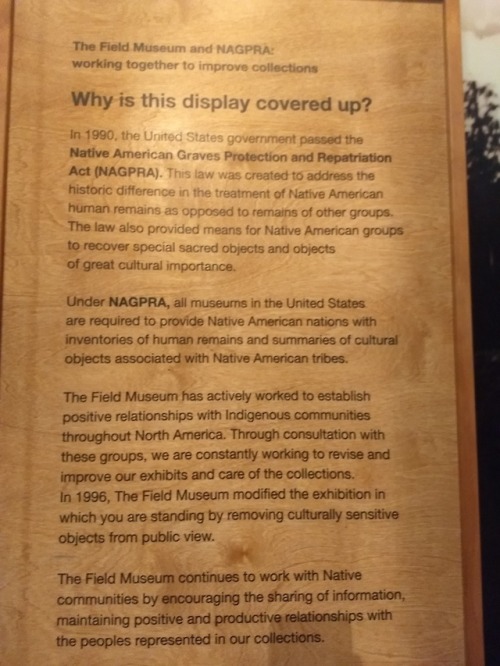
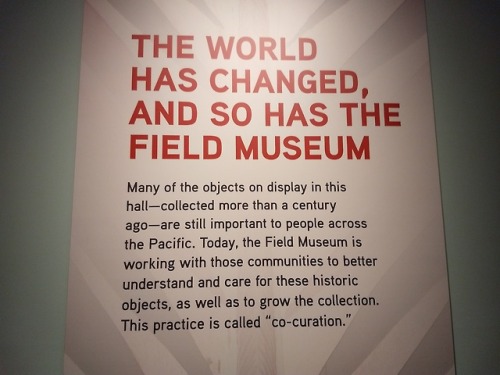
So I will admit I was feeling funny about going to the Field Museum because of the whole “look at display of objects from colonized groups” thing. Especially because of the Black Panther post with commentary on museums.
But boy, the Field Museum really does seem to be doing a fair amount towards rectifying past attitudes and actions. I took these two pictures and there were at least two others I wish I had remembered to take pictures of. I was thrilled to see such obvious mentions of this kind of thing instead of a lack of change or pretending it didn’t happen.
@kaijutegu I’ve been meaning to post these for the past few days, every time I see the BP museum post go by again!
Other dragons, mostly! Side-facing eyes offer a wider range of vision with which to watch the skies. Being caught off guard would most certainly not be good. Though in more recent times I’m sure it’s helped many a chromatic spot smaller would-be hunters. Metallics are less aggressive, but still need to defend themselves from territorial chromatics and the occaisional roc (though a wary dragon typically avoids nesting grounds). Besides, it’s fairly likely the side-facing eyes emerged in all dragons’ common ancestor before they diverged into color-categories.
A sudden, terrifying thought
When you see an animal with its eyes set to the front, like wolves, or humans, that’s usually a predator animal.

If you see an animal with its eyes set farther back, though—to the side—that animal is prey.

Now look at this dragon.

See those eyes?

They’re to the SIDE.
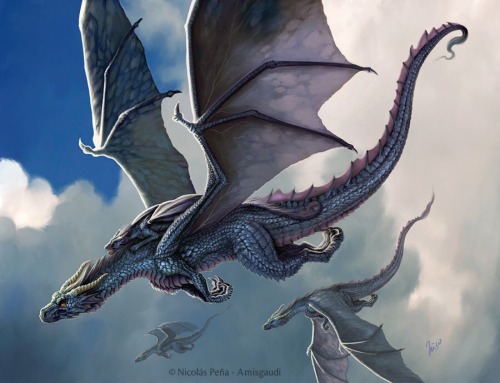
This raises an interesting—and terrifying—question.

What in the name of Lovecraft led evolution to consider DRAGONS…
As PREY?

Scientists have figured out how to use nuclear waste as an energy source, converting radioactive gas into artificial diamonds that could be used as batteries.
These diamonds, which are able to generate their own electrical current, could potentially provide a power source for thousands of years, due to the longstanding half-life of the radioactive substances they’re made from.
“There are no moving parts involved, no emissions generated, and no maintenance required, just direct electricity generation,” says geochemist Tom Scott from the University of Bristol in the UK.
“By encapsulating radioactive material inside diamonds, we turn a long-term problem of nuclear waste into a nuclear-powered battery and a long-term supply of clean energy.”
Continue Reading.
I remembering being at the Monterey aquarium a few times and I recall it's repurposed from a cannery. Does the aquarium have a book of the building's history? I'd love to buy it and read up on the local history.
It’s true! The Aquarium stands on the site of the former Hovden and Sea Pride canneries. Here’s a brief history of the Aquarium. For a longer read, this book delves into the history of Monterey Bay, including the Aquarium!
The canneries are an important part of Monterey Bay history and you can find tributes to them throughout the Aquarium, including the smokestacks on the roof and the boiler exhibit in the atrium.

The smokestacks! They’re now sealed and primarily used as a perch by peregrine falcons searching for prey.

Restored boilers—fish would be cooked in these as part of the canning process.

Old Hovden Cannery building as seen from Hopkins Beach in the late 60′s. (📷: Mark Silberstein)

Same spot today! The Aquarium building incorporates some of the original structures and style of the canneries. You can read more about the architectural design of the Aquarium here.
Isn’t it strange that we talk least about the things we think about most?
Charles Lindbergh (via purplebuddhaquotes)
can’t relate


